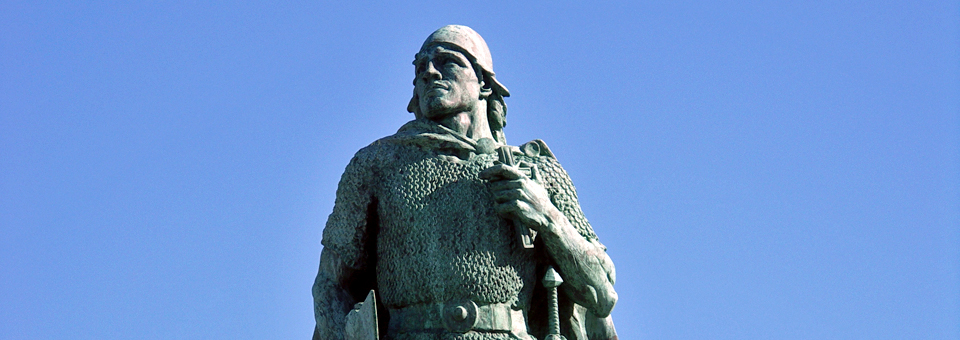
by Fr. Geoffrey Korz
“Where two or three are gathered together in My name, I am there in the midst of them.” – Matthew 18:20
The tiny community of L’Anse aux Meadows at the far northern tip of Newfoundland is distinguished among Canadian heritage sites as the oldest European settlement in Canada. Scarcely a dozen buildings remain of this Viking settlement, constructed over one thousand years ago by a group of Scandinavian settlers who appeared ready to make a new home in the frigid northlands of what would later become Canada.
It is almost certain that the tiny group was led by a Viking named Karlsefni, an associate of Leif Erikson (called Leif the Lucky, for his many extraordinary successes), one of the first Norsemen to accept baptism within a largely pagan culture. By the time these settlers arrived in Canada, Christianity and paganism were living side by side in northern Europe, and had not yet had the opportunity to discover the differences which would inevitably lead to conflict. The Norse were a pragmatic lot, whose religious zeal was usually focused on doing whatever it took to survive and to win. And the Christian God was the ultimate Victor.
A delightful story is told of the curious Viking habit of seeking repeat baptisms; it seems the Norsemen were drawn to baptism, every year, at the hands of Saint Ansgar and others, enjoying the fresh white shirt and ten silver talents they customarily received at the hands of the priest, if only they would allow themselves to be submerged beneath the sacred waters (Joseph Lynch, Christianizing Kinship, p. 73). For the average pragmatic Viking, multiple baptisms simply made sense: it conferred spiritual as well as material benefits desperately needed in a seagoing culture, where life was hard, brutish, and short.
It is understandable that Orthodox clergy in the Norse lands immediately curtailed the Viking zeal for multiple baptisms, just as soon as it came to their attention. (The throngs of Norsemen must have been a bit of a blur to the average missionary priest. One can only imagine the encounters and conversations between the eager Vikings and the bewildered clerics). But just as with mission work today, only God can plumb the depths of the heart of a Christian man, and perhaps the Vikings did have their fair share of zealous converts, offering silver crosses as illustrations to the Odin worshipers of the God Who destroyed Death Itself. For a Norseman, just as for us today, one cannot do better than that.
We know that the Norse seafaring parties who traveled to North America contained mixed crews of Thor-worshipers and Christians (Erikson himself started out as the former, and ended up, rather early in life, as the latter). We also know that one of the parties of settlers his adventures produced the first Canadian-born child of European extraction, a boy named Snorri, whose grandchildren included three bishops right around the time of the Great Schism (news of which traveled very slowly to Viking lands, in any case).
Perhaps here we have a glimpse of the first Christian community in Canada: a tiny one, to be sure, and not organized as far as the Church is concerned. Their firstborn child was almost certainly baptized, although probably back in the old country, once his parents joined their companions and fled from the North American natives who never seemed to take a liking to the Norse tendency to attack on sight. Outnumbered, far from home, and cold (yes, even Vikings get cold), it was perhaps inevitable that the first Orthodox settlement in Canada was not to last. It would seem the unfortunate trend of Orthodox Canadians looking back to the old country and not putting down roots in the west was established early on.
It is almost certain that no Orthodox priest was present at the first settlement at L’Anse aux Meadows. Yet archaeological digs further northwest on Baffin Island present an interesting possibility. A thirteenth-century Thule native site produced an intriguing relic: a tiny carved figure dressed in European clothing, with evidence of a cape over the shoulders, and a long cloth draped around the neck, hanging down to the feet – and marked with a cross. Robert McGhee, who specializes in Arctic archaeology at the Canadian Museum of Civilization, suggests this figure shows a crusader who served as a retainer for a viking captain. This is based on the theory that Christian clergy in northern Europe did not wear pectoral crosses until a much later period.
Yet we know both Saints Cuthbert and Adamnan, saints of the Orthodox west, both wore such crosses, as we can see today on display at the cathedral in Durham, in the north of England. It seems more difficult to believe that a crusader would have traveled thousands of miles with pagan Vikings, rather than a Christian priestmonk, seeking out mission territory, or more likely, seeking a remote monastic home, as we know the Celts did in Greenland centuries before. Whether this figure represented an Orthodox priest or a cleric of the western Latins after the Schism, we’ll likely never know.
But for Orthodox Christians in Canada, the rubble at L’Anse aux Meadows and the carving from Baffin Island remind us that a minute Orthodox presence likely existed in Canada long before two world wars, and long before the Reformation. These facts confirm that the first Christians to set foot on our soil were from what is sometimes erroneously called the “undivided Church” – the Orthodox Church before the breaking away of Rome. And our brother Leif the Lucky, along with his kinsmen at L’Anse aux Meadows – and perhaps even a lone priestmonk on Baffin island, were what one might think of as founding members of the first Orthodox community in Canada – whether they knew it, or not.
Source

Leave a Reply